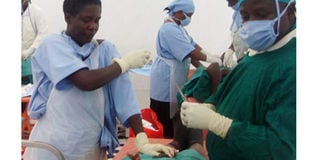Uganda registers a decline in male circumcision numbers

Health workers perform surgical circumcision in Jinja recently.
What you need to know:
- The reduction came after government adopted a two dose Tetanus Toxid (TT) vaccination program for VMMC clients on recommendation of the World Health Organisation (WHO).
- Tetanus Toxoid is a vaccine that is used to prevent against Tetanus which bacterial infection is transmitted when the germs get into contact with broken skin, wound or cut.
KAMPALA:
Uganda has registered a drastic decline in the number of voluntary medical male circumcisions (VMMC) from 900,000 procedures conducted annually in the past years to 556,000 in 2015.
Circumcision has been widely favoured in the prevention of HIV/Aids after evidence from previous studies conducted in Uganda, South Africa and Kenya showed that it could reduce a man’s risk of contracting HIV/Aids by about 60 per cent.
Dr Joshua Musinguzi, the Aids Control Programme manager at the Ministry of Health said the reduction came after government adopted a two dose Tetanus Toxid (TT) vaccination program for VMMC clients on recommendation of the World Health Organisation (WHO).
“We give two tetanus jabs at least four weeks apart before one is circumcised immediately after receiving the second jab but some people disappear after receiving the first one,” Dr Musingunzi told Daily Monitor in an exclusive interview.
He added that: “You cannot achieve the same numbers because people have to come and go but the numbers have since picked up and we are yet to release the 2016 final report.”
Tetanus Toxoid is a vaccine that is used to prevent against Tetanus which bacterial infection is transmitted when the germs get into contact with broken skin, wound or cut.
WHO recommended the integration of TT vaccination into VMMC services after nine cases of tetanus infections were reported in Uganda between 2013 and 2015 of which four resulted into death.
According to the recommendations, Ministries of Health were advised to develop and phase-in effective and practical delivery strategies for providing tetanus vaccination in the context of their VMMC services.
However, although the WHO recently clarified that it was not a must to have a tetanus jab before circumcision due to the background immunity from childhood vaccines; the ministry has not altered this yet.
Dr Musinguzi promised that the ministry will this month be meeting different stakeholders to agree whether to review the policy and adopt the new WHO recommendations.
“Once we have consensus and it is approved by the top management here and the [Health] Minister, we shall be able to start giving only one jab for surgical circumcisions but maintain the two jabs for nonsurgical circumcision,”
Although the Uganda AIDS Commission (UAC) set a national target of 4.2 million male circumcisions to be performed by the end of 2015, by October 2015, more than 2.6 million men (62.2per cent) of the national target had been circumcised.
It is not clear whether President Museveni’s earlier campaign against the promotion of circumcision in the fight against HIV/Aids could also have contributed to the decline in the numbers.
During the World Aids Day celebrations on December 1, 2012, president Museveni said that promoting circumcision in the fight against HIV/Aids will encourage recklessness among the youth.
Instead, the president advised Ugandans to return to morality and sexual discipline if the scourge is to be fought effectively adding that HIV/Aids is not a medical but a moral problem that should be treated as such.
The Safe Male Circumcision policy of 2010 is funded by the US Presidential Emergency Plan for AIDS Relief (PEPFAR), through the Centres for Disease Control and Prevention (CDC).




